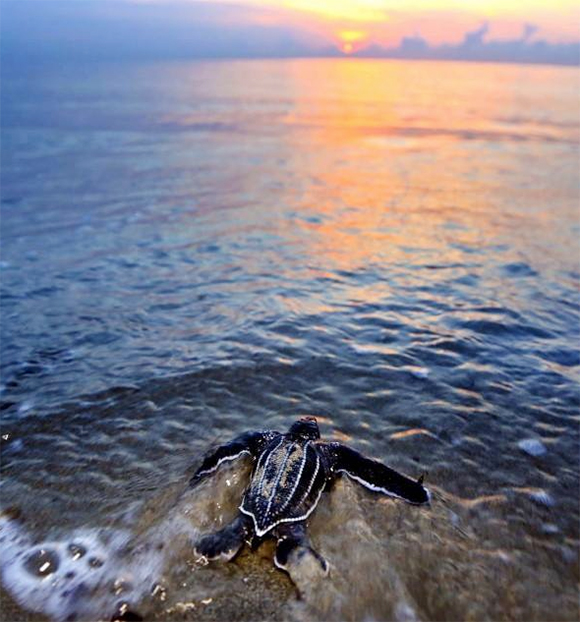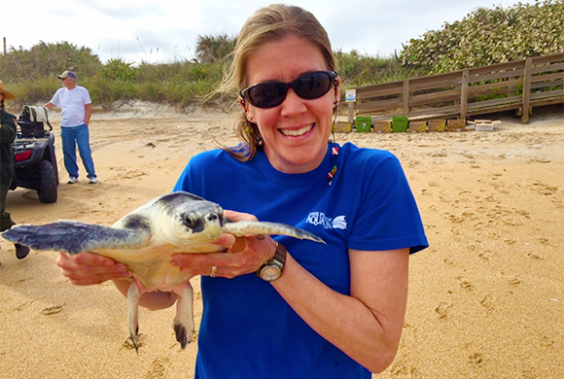Florida Fish and Wildlife: Sea Turtle Nesting Season Now In Full Swing
By Space Coast Daily // May 3, 2016
NESTING SEASON OFFICIALLY BEGAN MAY 1
ABOVE VIDEO: An educational video by ‘SEE Turtles’ about the nesting process of sea turtles. (SEE Turtles video)
BREVARD COUNTY, FLORIDA – Sea turtle nesting season began May 1 on many Florida beaches, including the sandy beaches of Brevard County.
The season lasts through the end of October and is the critical time when people can help keep sea turtles and hatchlings safe.
Thousands of endangered and threatened sea turtles nest on Brevard County’s beaches each year.
Loggerhead turtles that nest on beaches in Franklin, Gulf, Bay, Walton, Okaloosa, Santa Rosa and Escambia counties are part of a distinct subpopulation that scientists were concerned was in decline. However nest numbers for this species were up in 2015, when 1,499 loggerhead turtle nests were documented in these seven Gulf Coast counties. Green and leatherback turtles also nest on northwest Florida beaches, although in much lower numbers.
“In order to keep sea turtles and our beaches and oceans healthy, it’s important for all of us to be good neighbors and do our part,” said Dr. Robbin Trindell, who leads the sea turtle management program at the Florida Fish and Wildlife Conservation Commission (FWC).

The FWC recommends residents and visitors in northwest Florida and all coastal communities follow a few simple guidelines in order to help conserve sea turtles and their hatchlings. Beach residents and visitors are encouraged to follow these tips:
1. Do Not Disturb. During nesting season from May through October, it’s important to keep your distance from nesting sea turtles, their nests, whether eggs are visible or not, and their hatchlings. In northwest Florida, nests are usually marked with distinctive yellow signs and tape, but not always. Please don’t shine lights on sea turtles or hatchlings or take photos of them – including cell phone photos.

2. Use the Right Light to Help Them at Night. Turn off or adjust lighting along the beach in order to prevent nesting females or hatchlings from getting confused and going toward lights on land instead of the salt water, where they belong. Use turtle-friendly lighting on outside lights on homes and other buildings along the beach. Replace incandescent, fluorescent and high-intensity bulbs with FWC-certified low-wattage, long wavelength options available in red or amber colors. Turn out outdoor lights at night when not needed. Remember with beach lighting to:
• Keep It Long – Long wavelength lights are better for turtles. Look for the red and amber lights that have been certified as turtle-friendly by FWC.
• Keep It Low – Illuminate walkways by installing lights close to the ground.
• Keep It Shielded – Focus lights down, not up or outward, to avoid confusing nesting turtles and hatchlings.
• Shut Curtains and Blinds – Close curtains and draw blinds at night on beachfront windows and doors.
3. Clear the Way at the End of the Day. Nesting mothers and hatchling sea turtles can get trapped or confused by beach furniture left on the beach at night. Beach furniture also can cover sea turtle nesting areas. Please bring furniture (such as beach chairs, umbrellas, buckets and tents) back to your house, condo or hotel at the end of the day and fill in holes or level piles of sand before nightfall.
Also please avoid burying umbrella poles in the sand; use pole-holders or sleeves instead. Properly dispose of any trash, food or other litter in covered trash cans to avoid attracting predators to the nests.
The FWC works to conserve Florida sea turtles, including coordinating nesting beach survey programs around the state. Report sick, injured, entangled or dead sea turtles to the FWC’s Wildlife Alert Hotline: 1-888-404-3922, #FWC or *FWC on a cell phone or text Tip@MyFWC.com.
CLICK HERE FOR MORE INFORMATION













